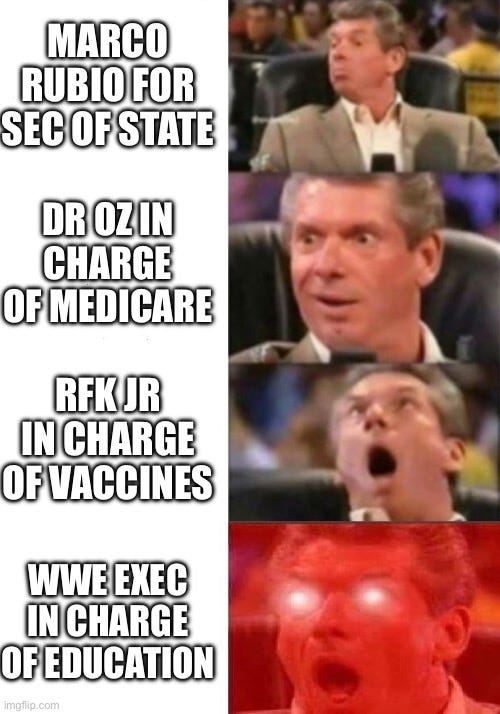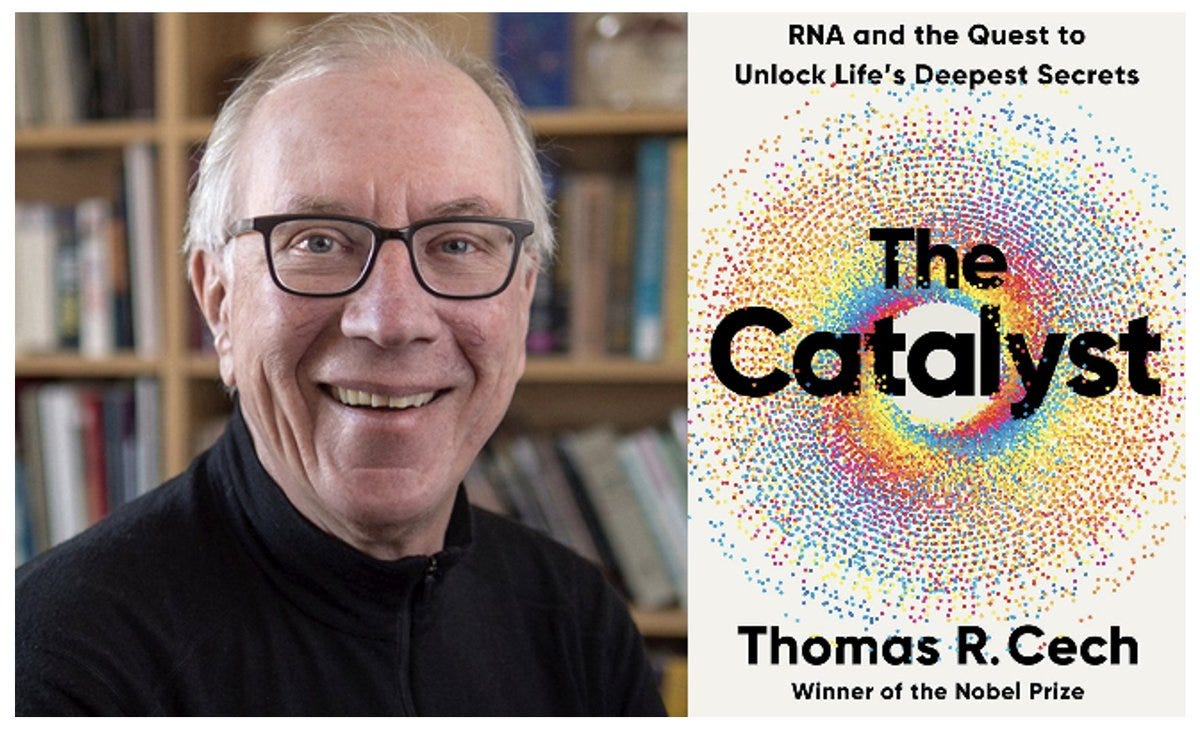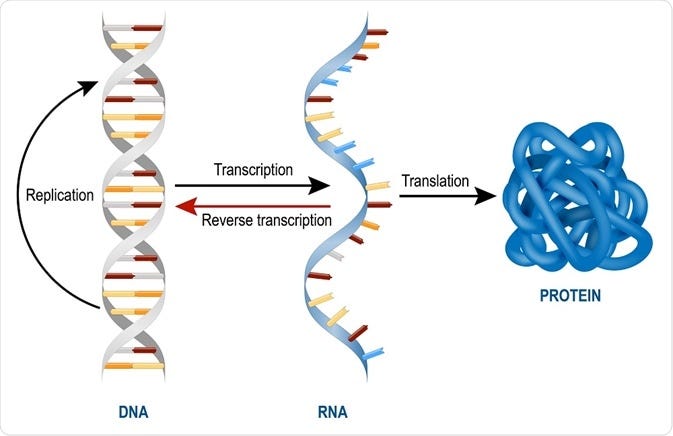Dear Readers,
Today I’m going to take a break from writing about politics (thank God) and get back to focusing on science and medicine. While I have never shied away from discussing the impact of government policy on health and research, even I have limits on how much mental energy I can devote to the topic. The incoming administration is already doing their best to deliver on the chaos they promised, so all I can do for the next few years is laugh in darkly detached irony at things like this:

Let’s now turn our attention to the book I will be reviewing in this week’s newsletter, “The Catalyst: RNA and the Quest to Unlock Life’s Deepest Secrets.”1 The author, Dr. Thomas Cech, is a chemist who won the Nobel Prize in 1989 for discovering RNA molecules could function as enzymes (termed “ribozymes”). The Cech lab was also critical in understanding how telomeres and telomerase work. The Catalyst offers an insider account of the last 50 years of molecular biology research that takes readers on a journey that reframes how we understand life at its most fundamental level.
—Eric
The Catalyst is split into two main sections. Part I: The Search focuses on the basic science research into understanding mechanisms of how RNA is made and functions in the cells of people and animals. Part II: The Cure dives into the medical use of RNA as drugs, vaccines, and other clinical applications.
Cech’s ability to ground esoteric science in human stories is a hallmark of the book. We first meet him as a young graduate student puzzling over unexpected experimental results. Later, as he becomes the head of a major laboratory we get a front row seat into the race between scientists all over the world competing to unlock RNA’s secrets. Colorful anecdotes about the odd cast of characters in this story give The Catalyst a pulse, reminding us that science is as much about curiosity and persistence as it is about precision.
In the beginning, there was…RNA?
Ever since Watson and Crick discovered the double-helix in 1953, high school students all over the world learned the central dogma of molecular biology: DNA is the molecule that shapes who we are by coding for the tens of thousands of proteins in our bodies. RNA was viewed as a necessary but not particularly interesting intermediate between those two critical types of molecules.
When our cells make proteins, an enzyme called RNA polymerase “transcribes” relevant portions of the DNA template in our genes into a short-lived “message” made of RNA (mRNA), which functions like a carbon copy of an office memo with instructions for a project (leaving the original untouched and archived). A group of structures called ribosomes “translates” that memo into a protein by stitching together a chain of amino acids as specified by the mRNA. This flow of information only went in one direction (with the exception of reverse transcription in viruses like HIV).
As often occurs in science, that rigid view began to change when people noticed some things that didn’t make any sense. First, as scientists began to analyze the chemical composition of those ribosomes, they were surprised to find that most of the weight was actually RNA, not proteins as had been assumed for decades. The structure and function of this new class of ribosomal RNA (rRNA) was followed by the discovery of adapter molecules called transfer RNA (tRNA) that help connect the right amino acid to the right mRNA sequence as a protein is assembled. These discoveries were not just cool “gee whiz” trivia facts; they have profound implications for medicine. The majority of antibiotics we use today selectively inhibit portions of bacterial ribosomes but not human or animal versions. The small differences in rRNA sequences also helped us to survey the diversity of bacteria in our bodies, enabling the new field of microbiome research.
The story gets weirder and more interesting. Scientists discovered that mRNA is spliced and diced from its original form to let the same gene produce multiple different versions of proteins. What’s more, sometimes this splicing process goes haywire and the defects produce serious diseases like spinal muscular atrophy.
RNA splicing led directly to Cech’s journey into ribozymes. He was studying a microbe found in pond scum called Tetrahymena when he noticed that it appeared to be self-splicing it’s mRNA without any help from proteins! Another longstanding dogma of biology was that only proteins could function as enzymes that catalyze chemical reactions. Yet his data showing self-splicing RNA were repeatable and unambiguous. His discovery had single-handedly upended a century of assumptions about how cells worked, and soon other research groups were discovering more ribozymes.
Part I of the book concludes with the speculative research by Jack Szostak and others into the origins of life itself. For many years, scientists wondered which came first, DNA or proteins, in a true chicken-or-the-egg problem. Compelling findings in test tubes suggested an elegant answer: Neither. Instead, it is likely that RNA, which can both code for information like DNA and function as an enzyme like a protein, was the original stuff of life. When the earliest RNA molecules were able to mix with a lipid shell, you have pretty much all the ingredients necessary for primitive single cell organisms!
I was actually fortunate to see Dr. Szostak speak at Auburn University in 2015 and was blown away by his work. Interested readers can find a version of that lecture below:
21st Century Medicine
The second half of the book focuses on how RNA can actually be used in the real world. Cech discusses how his lab discovered an enzyme called TERT (telomerase reverse transcriptase) that is critical in repairing telomeres, the “caps” at the ends of our chromosomes that prevent DNA damage over time (TERT requires an RNA template to work backwards). Telomeres play an important role in the development of cancer, and 9 in 10 tumors have mutations in TERT. Direct and indirect inhibitors of TERT are currently in clinical trials. Furthermore, manipulating telomeres may some day be the basis of anti-aging therapies (although they are not yet ready for prime time).
In a fitting twist, many diseases that start with an RNA defect can also be repaired with RNA. For example, the disease spinal muscle atrophy (SMA) mentioned earlier used to be considered uniformly fatal in infancy or early childhood. However, the drug Spinraza (approved by the FDA in 2017) and others like it manipulate RNA splicing back into the correct alignment and dramatically improves the length and quality of life in patients. SMA is quickly going from a rare genetic death sentence to a manageable chronic illness.
Another chapter explores CRISPR, the groundbreaking technology that can be used for (relatively) precise gene editing. Interestingly, CRISPR was first discovered in yogurt bacteria by food scientists at DANISCO. This technology is now being used to cure patients with sickle cell anemia.
I particularly enjoyed the chapter on RNA interference (RNAi) and microRNA (miRNA). microRNA shows promise as novel oncology biomarkers as well as therapeutic targets for cancer. And the scientists who studied miRNA in the embryonic development of the translucent worm C. elegans just won the 2024 Nobel Prize in Medicine or Physiology.
Side note: I studied the role of microRNA in dogs with mammary tumors during my PhD:
microRNA in Cancer
microRNA, as the name implies, are small molecules made of—you guessed it!—RNA. Researchers discovered that this class of nucleic acids had powerful control over embryo development in small invertebrates like the worm Caenorhabditis elegans in the 1990s. Soon, microRNA (sometimes called miRNA or miRs, produced “meers”) were discovered in virtually all species more complicated than bacteria, including plants, fungi, and all mammals.
Finally, no book on RNA could be complete without discussing Covid-19. Coronaviruses like SARS-CoV-2 are little more than particles of RNA with a few associated proteins to help them enter and hijack host cells. In a similar vein as SMA above, pioneering scientists like Dr. Katalin Kariko figured out how to use mRNA to produce fragments of a target protein to train the immune system against it. The mRNA-based vaccines from Pfizer (and Moderna) were initially 95% effective, an astounding result for a vaccine against an RNA virus (for reference, the seasonal flu vaccine is usually only 40% effective), and directly contributed to ending the emergency phase of the pandemic.2 The same mRNA technology is currently being used to create vaccines against other infectious diseases and even cancer.
Final Thoughts
The Catalyst is a love letter to RNA and all of its complexity and contradictions. He explains how this seemingly unassuming molecule folds into intricate shapes, giving it the power to splice genes, guide protein synthesis, and regulate cellular processes. His writing is both accessible and engaging, making complex scientific concepts understandable to a broad audience. And he deftly connects these molecular marvels to big-picture ideas, from the origins of life to the modern frontier of RNA drugs.
Ultimately, The Catalyst isn’t just about RNA—it’s about the spirit of discovery. It’s a timely reminder that science advances not in neat, predictable steps, but through the messy, exhilarating process of exploration, and today’s medical miracles stand on the shoulders of yesterday’s curiosity-driven questions about something as humble as pond algae or yogurt bacteria. Cech champions the value of basic science, which is increasingly under attack and at risk of being defunded in favor of supposedly more “practical” research.
For readers of All Science Great & Small, this book hits all the right notes: molecular biology’s cutting edge, historical perspective, and an eye to the future of medicine. Dr. Cech’s passion for his subject is infectious, making The Catalyst a must-read for anyone intrigued by the molecules that make us tick—and the people who dedicate their lives to unlocking their secrets.
I don’t receive any affiliate link commission from Amazon or any other business, it’s just the most convenient site to view and buy the book
I realize that for people with disabilities, immunosuppression, and long COVID, the pandemic is very much not over








